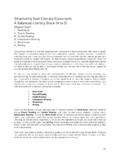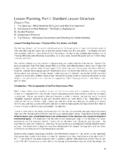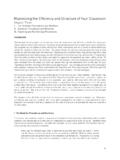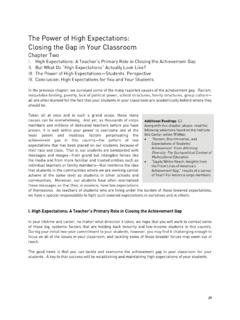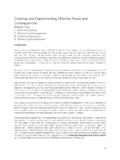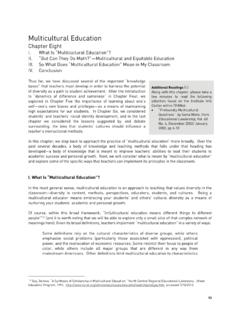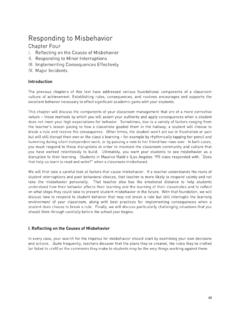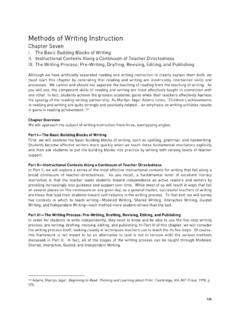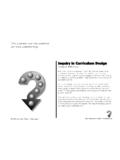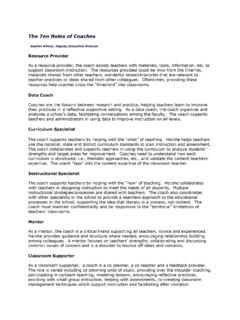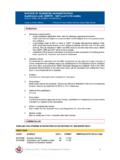Transcription of 1 IPD InsideCover 2011 - Teaching as Leadership
1 Unit Planning Chapter Four I. Develop Your Unit Vision II. Create Your Summative Unit Assessment III. Translate Your Learning Goals Into Lesson Objectives IV. Sequence Your Content and Scaffold Your Lesson Objectives V. Schedule Your Objectives on the School Calendar VI. Create Your Beginning-of-Unit Diagnostic Tool VII. Create a Tracking System for Your Objectives VIII. Continually Adjust Your Plan Introduction A unit plan continues the mapping process that you began with your long-term plan. Just as your long- term plan sets out the goals and pacing for the whole year, your unit plan sets out your goals and pacing for the discrete slices of the year to which you have assigned your learning goals. In fact, one might think of a unit plan as almost the same thing as a long-term plan, but applied to a month or six weeks rather than the whole year.
2 If the long-term plan is analogous to an entire hiking trail, the unit plan might be analogous to a particular leg of the journey. Check out the Sample Unit Plan and Assessment in the Instructional Planning & Delivery Toolkit (pp. 36-48); this Toolkit can be found online at the Resource Exchange on TFANet.. While it is imperative that you think through and create your long-term plan before or at the beginning of the school year, many teachers complete their unit plans as the previous unit comes to completion. Thus, you might have six to ten major step-back sessions during the year to reflect on the last four-to-six- week unit and plan out the next one. This would allow you to make adjustments for skills and concepts from the previous unit that need to be reinforced, as evidenced by the end-of-unit assessment.
3 Other teachers find it helpful to flesh out their six to ten unit plans before the year begins, and then make adjustments and modifications as the year progresses. Why Do We Need a Unit Plan? In simple terms, a unit plan is simply a shorter-term, more detailed view of your Teaching map than your long-term plan. Yet in many ways, it has a very similar purpose. Unit planning provides you with a sense of direction and organization that again helps you and the class to achieve significant academic gains within a particular time period. More specifically, creating a plan to reach short-term goals has the following benefits: A unit plan forces you to make difficult decisions about what to teach and how to teach it. After taking the time to develop a unit plan, you are less likely to be side-tracked by objectives, lessons, or activities that do not advance your ultimate quest for academic achievement.
4 Tempting diversions will look much less appealing if you have your sights set on your students achieving a particular set of goals in a particular four-to-six-week period. A unit plan keeps you on pace to reach your unit (and ultimately long-term) goals. Your unit plan, which should be referred to with almost daily frequency, is your point of reference when you ask yourself, Given where I want to be in two [or four or six] weeks, am I where I need to be now? Am I spending too much time on certain skills and concepts given the other skills and concepts 53. Unit Planning that must be included in these X weeks, or X days? Given the limited number of weeks, days, and lessons in a unit, each moment becomes more precious, forcing you to pace yourself appropriately in order to meet your end goals.
5 A unit plan provides an opportunity to stimulate student interest through overarching content that is relevant to students. When you design your unit plan, consider what content will engage your students given their interests and backgrounds. As Jere Brophy indicates in Tomorrow's Teachers, whether in textbooks or in teacher-led instruction, information is easier to learn to the extent that it is coherent ( , a sequence of ideas or events makes sense and the relationships among ideas are made apparent). Content is most likely to be organized coherently when it is selected in a principled way, guided by ideas about what students should learn from studying the topic. 14 Your unit plan does precisely that it creates discrete segments of learning that have a cohesive unity. And, you will help engage your students in learning because each unit will have an overarching idea that is relevant and interesting to students.
6 Creating Unit Plans To create a unit plan that meets the above purposes and provides you with daily instructional guidance, many effective teachers use the following series of eight interdependent steps: I. Develop your unit vision II. Create your summative unit assessment III. Translate your learning goals into lesson objectives IV. Sequence your content and scaffold your lesson objectives V. Schedule your objectives on the school calendar VI. Create your beginning-of-unit diagnostic tool VII. Create a tracking system for your objectives VIII. Continually adjust your plan Note that these steps represent the same backwards-planning framework that we used at the assessment and long-term plan levels. They have been tried, tested, and used by many effective teachers and, thus, constitute a set of guidelines for reaching the purposes of unit planning.
7 This process should not be thought of, however, as a checklist or as a series of discrete, linear steps to unit planning. As you will see throughout this chapter, many of the actions are interrelated and will need to be reused or revisited at multiple stages in the planning process. Avoid rigid adherence to each step. Such an approach may lead you to lose sight of your underlying purpose clearly understanding your destination and developing a plan to reach this goal. Always reflect on the rationale for completing each stage in the process and think of the ways in which one action connects to and influences the other steps in the process. We will consider each step in turn, although you may recognize some steps (namely the creation of a beginning-of-unit diagnostic and an end-of-unit assessment) from Chapter Two.
8 I. Develop Your Unit Vision You have probably heard teachers talk about Teaching units. This generic term refers to what results when you transform various buckets of learning goals (created in your long-term plan) into a coherent set of lessons. For example, a high school English as a Second Language teacher might allocate six weeks to a poetry unit, in which a whole range of learning goals from vocabulary to research skills . Brophy, Jere. Generic Aspects of Effective Teaching . Tomorrow's Teachers, ed. Margaret C. Wang and Herbert J. 14. Walburg. Richmond, CA: McCutchen Publishing Corporation, 2001, p. 24. 54. would be covered in the context of studying poetry. A middle school teacher might study a particular grouping of learning goals and realize that designing a museum in the classroom might be a great way to engage students in all of those learning goals.
9 An elementary school teacher might notice that her class is just fascinated by firefighters and police, and she might decide to teach each of the learning goals she has grouped for the next six weeks through a unit on careers in the community. Before you determine what type of unit to present, however, it is necessary to develop a strong unit vision - a clear understanding of your ultimate goal for student learning. At this stage in your planning process you need to answer the question, What would it look like for my students to master the unit learning goals? Without this clear vision of where you are going, you will be unable to effectively organize your instruction. Up to this point you have developed a course-level understanding of your learning goals in creating your big goal and long-term plan.
10 To develop your unit vision, continue this process of unpacking your learning goals using the resources described in Chapter One, including veteran teachers, exemplary student work, and grade-level assessments. Determine what exactly your students should know or be able to do by the end of the unit if they have achieved the learning goals. This will allow you to clearly envision the unit's purpose and destination and prepare you to determine what evidence students must produce in order to demonstrate mastery. You may already have a clear understanding of what student mastery will look like for your unit from your prior work in digesting your learning goals and standards. If so, you may not need to unpack' your learning goals any further to produce a sufficiently clear unit vision. Before you proceed, however, make sure that you can concretely describe in detail the most important things for your students to learn, and what it will look like for students to demonstrate that they have achieved the unit goals.
